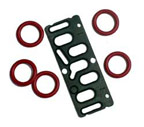
|
7108
S. Alton Way, Unit I |
(303) 758-2728
Home > Tips > Mechanical Seals
|
Tip: Mechanical SealsThe start-up process for pumps can be a critical time when problems arise with the mechanical seals they contain. The pump manufacturers do not necessarily give instructions on the right procedures to follow to protect the mechanical seals when the pumps are turned on and the seals can be ruined if the proper steps are not followed. For example, most pumps are self-venting but that does not mean that the stuffing box area is vented. To make sure the mechanical seals do not run dry, the stuffing box must be relieved of air. Sometimes a pump in a critical application will be hooked up to a stand-by pump in case there is a problem. However, if the mechanical seals in the stand-by pump are not made from the right elastomer, they could have a tendency to harden, distort their shape or stick to the shaft if the pump is not used for a long period of time. Obviously, then when the stand-by pump is needed and turned on, the mechanical seals in it will fail. If you have mechanical seals that have failed, it is important to look at them to determine what caused the failure. There are many factors that cause failure:
|
We are located in the Denver Technological
Center in a suburb of Denver, Colorado
©1997-2017, Problem Solving Products, Inc.
Website Map | Privacy Statement
| Terms of Use

